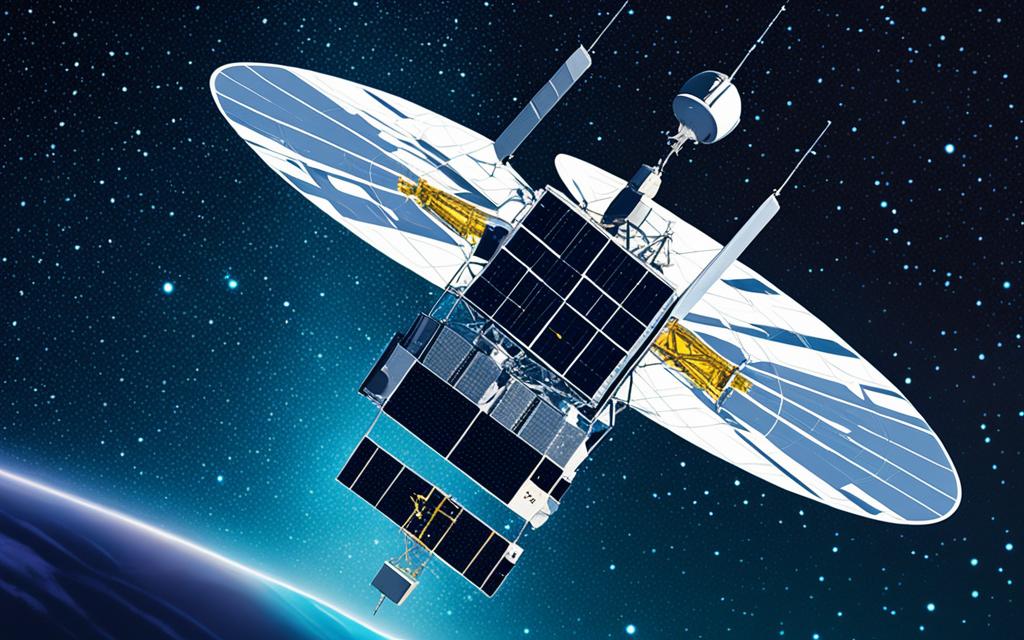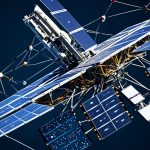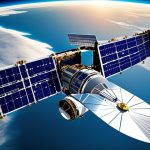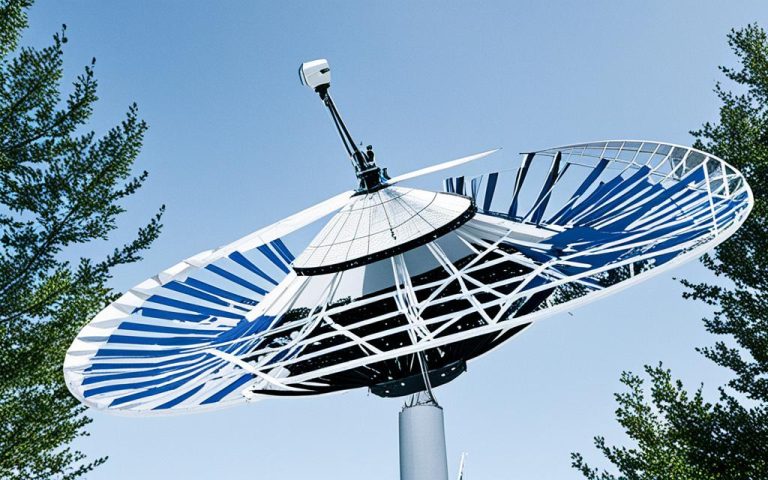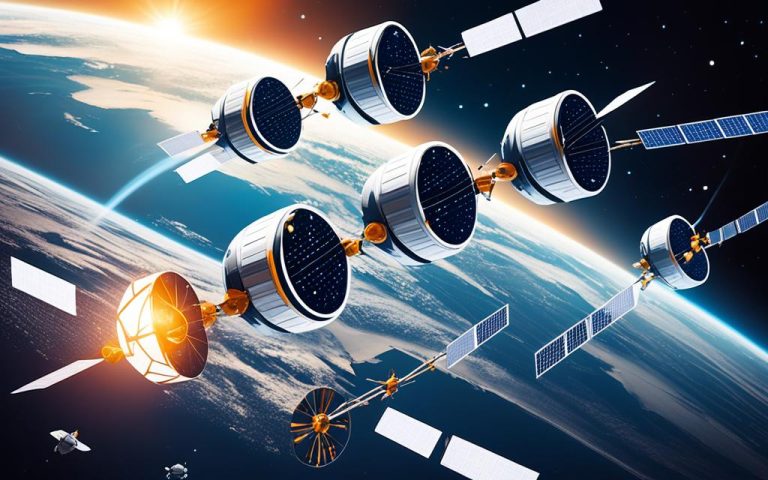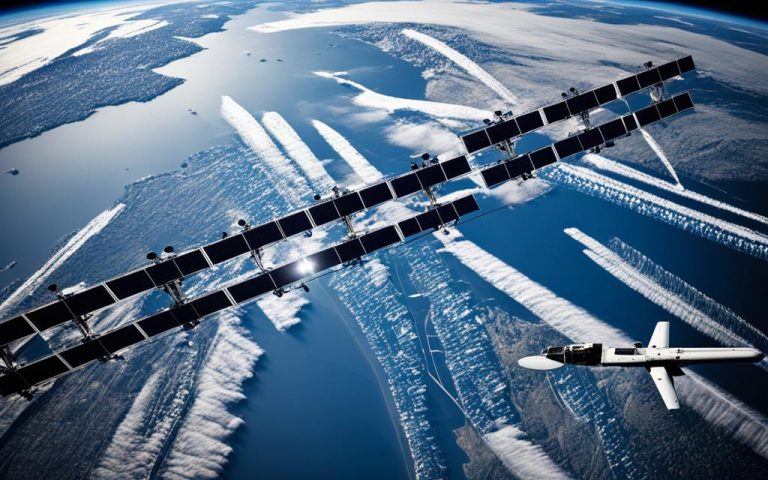Satellite technology has revolutionized our lives and continues to do so. With recent advancements, satellite connectivity is now being used to bridge the connectivity gap and enable IoT expansion in remote areas. This article explores the potential of satellite IoT connectivity in providing global coverage and optimizing IoT operations.
As the Internet of Things (IoT) becomes more prevalent, the need for seamless connectivity becomes increasingly important. While traditional cellular networks play a significant role in connecting devices, their coverage is often limited to populated areas. That’s where satellite IoT connectivity comes in.
Satellite IoT connectivity ensures that devices in remote locations can stay connected to the global IoT network, regardless of their geographical position. Whether it’s monitoring weather conditions in remote farms or tracking assets in the maritime industry, satellite networks provide the necessary infrastructure for global IoT solutions.
One of the key advantages of satellite IoT connectivity is its ability to provide coverage in areas where terrestrial networks are unavailable or inefficient. By leveraging cutting-edge technology, satellite networks can offer seamless global coverage, allowing businesses to expand their IoT operations to previously untapped regions.
With satellite IoT connectivity, businesses can deploy IoT solutions in remote areas, optimize their operations, and tap into new markets. From agriculture and transportation to energy and logistics, the possibilities are endless. The global coverage provided by satellite networks ensures that no region is left behind in the IoT revolution.
This article will delve deeper into the advantages of satellite IoT connectivity and explore the different types of satellites used for IoT applications. We will also discuss the projected growth of satellite IoT subscribers and the future of satellite IoT connectivity.
Bridging the Connectivity Gap with Satellite Networks
Despite the significant progress in connectivity technology, many remote areas still suffer from insufficient network infrastructure, creating a connectivity gap that limits the potential of IoT applications. In these remote regions, traditional cellular networks are unable to extend coverage, leaving businesses and communities disconnected.
Satellite connectivity offers a game-changing solution by bridging this connectivity gap and providing IoT expansion in remote areas. With satellite networks, businesses can reach regions that are beyond the reach of cellular networks, enabling them to expand their IoT operations and leverage the benefits of a connected world.
The demand for IoT connectivity is growing rapidly, with businesses seeking to optimize their operations, increase efficiency, and unlock new opportunities for growth. However, without global network coverage, these goals remain out of reach. Satellite networks provide the answer, delivering seamless connectivity to even the most remote areas.
Empowering Remote Areas
Satellite networks enable businesses to extend their IoT applications to remote areas, empowering industries such as agriculture, energy, and maritime, as well as improving transportation and logistics. These industries often operate in remote and challenging environments where cellular network coverage is unreliable or nonexistent.
For example, in the agriculture sector, satellite-connected IoT devices can provide real-time monitoring and analysis of crops, enabling farmers to optimize irrigation, fertilization, and pest control. In the maritime industry, satellite connectivity allows for real-time tracking and monitoring of vessels, enhancing safety and efficiency.
“Satellite networks are revolutionizing connectivity in remote areas, empowering industries that were previously limited by inadequate network infrastructure. With global network coverage, businesses can fully realize the benefits of IoT technology and drive innovation.”
Overcoming Connectivity Limitations
Satellite networks overcome the limitations of traditional connectivity options in remote areas. While cellular networks rely on terrestrial infrastructure and are limited by geographical constraints, satellite networks can provide coverage anywhere on the planet.
By leveraging satellite IoT connectivity, businesses can:
- Monitor and manage assets in real time, regardless of location
- Enable seamless communication across vast areas
- Facilitate remote control and automation of operations
With reliable and comprehensive connectivity, businesses can optimize their operations, increase productivity, and unlock new revenue streams, regardless of their geographic location.
| Benefits of Satellite IoT Connectivity in Remote Areas |
|---|
| ✓ Global coverage, reaching even the most remote regions |
| ✓ Real-time monitoring and control of assets |
| ✓ Improved operational efficiency and productivity |
| ✓ Enhanced safety and security in challenging environments |
| ✓ Unlocking new opportunities for growth and innovation |
| ✓ Seamless communication across vast areas |
GEO vs. MEO vs. LEO satellites for IoT
When it comes to IoT connectivity, different types of satellites are utilized, including GEO (Geostationary Earth Orbit), MEO (Medium Earth Orbit), and LEO (Low Earth Orbit) satellites. Each of these satellite systems offers distinct advantages and limitations for IoT applications.
GEO Satellites:
GEO satellites are positioned at a high altitude above the Earth’s equator, allowing them to provide extensive coverage over large regions. This makes them well-suited for applications that require broad-scale global coverage. However, their high altitude results in long signal latency and limited data rates, which may not be ideal for latency-sensitive or high-bandwidth IoT applications.
MEO Satellites:
MEO satellites operate at a medium altitude, striking a balance between coverage and speed. They provide better latency and data rates compared to GEO satellites, making them suitable for applications that require more responsive connections. While MEO satellites offer improved performance, they still fall short of providing true global coverage, limiting their suitability for IoT deployments that require worldwide reach.
LEO Satellite Constellations:
LEO satellite constellations consist of multiple satellites operating at a lower altitude and faster orbital speed. This configuration enables them to deliver low-latency and high-bandwidth connections, making them ideal for mobile IoT applications. LEO satellites can ensure global coverage to all regions, including remote areas where cellular networks may be unavailable. The continuous movement of LEO satellites in orbit provides seamless connectivity and enables efficient data transfer for IoT devices.
To summarize:
| Satellite Type | Altitude | Latency | Data Rates | Global Coverage |
|---|---|---|---|---|
| GEO Satellites | High | Long | Limited | Yes, large regions |
| MEO Satellites | Medium | Lower | Improved | No, limited regions |
| LEO Satellites | Low | Low | High | Yes, all regions |
By carefully considering the advantages and limitations of each satellite type, organizations can choose the most suitable option for their specific IoT needs. Whether it’s the extensive coverage of GEO satellites, the balanced performance of MEO satellites, or the global coverage of LEO satellite constellations, satellite technology offers a range of solutions to enhance IoT connectivity on a global scale.
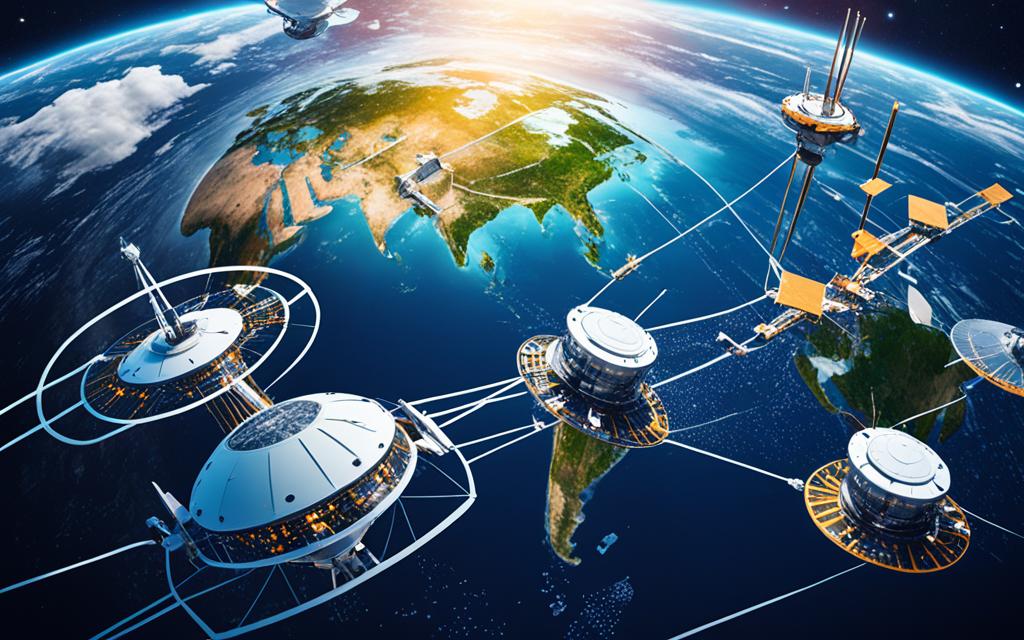
Unlocking the Potential of IoT with Satellite Networks
The integration of satellite networks with terrestrial 5G networks has opened up new possibilities for IoT applications. By leveraging satellite IoT connectivity, businesses can optimize operations, improve productivity, and unlock new opportunities for growth. Satellites play a crucial role in facilitating real-time monitoring and tracking in industries such as transport, logistics, agriculture, energy, and maritime, where cellular network coverage may be unreliable or nonexistent.
With satellite networks, IoT applications can thrive in remote areas that were previously beyond the reach of traditional connectivity solutions. Satellite IoT connectivity provides global coverage, ensuring that businesses can access data and monitor devices anywhere in the world. This seamless global connectivity allows for efficient data collection, analysis, and decision-making, enabling organizations to streamline operations and achieve higher levels of efficiency.
Let’s take a closer look at some of the key benefits that satellite networks offer for unlocking the potential of IoT:
1. Reliable Connectivity in Remote Areas
Satellite networks bridge the connectivity gap in remote regions where traditional cellular networks are unavailable. This is particularly valuable in industries such as agriculture and energy, where IoT devices need to operate in vast, rural areas. By harnessing satellite IoT connectivity, organizations can collect real-time data from sensors, track assets, and remotely manage operations, improving efficiency and reducing operational costs.
2. Global Coverage for Seamless Operations
The global reach of satellite networks ensures that businesses can enjoy uninterrupted connectivity and access critical data no matter where their IoT devices are deployed. Whether it’s a fleet of vehicles, a network of agricultural sensors, or a fleet of ships, satellite IoT connectivity provides the necessary infrastructure to monitor and control operations on a global scale. This enables businesses to make data-driven decisions, optimize logistics, improve safety, and meet regulatory compliance requirements.
3. Energy Efficiency and Environmental Impact
Satellite networks contribute to energy efficiency and sustainability by enabling smart energy management systems and environmental monitoring. IoT devices powered by satellite connectivity can gather data on energy consumption, track renewable energy sources, and optimize energy distribution networks. With this information, businesses and governments can make informed decisions to reduce their carbon footprint and work towards a greener future.
By leveraging the power of satellite networks, businesses can unlock the full potential of IoT applications and transform industries across the globe. The seamless global connectivity provided by satellite IoT networks enables organizations to optimize operations, improve productivity, and gain valuable insights. As businesses continue to embrace IoT solutions, satellite networks will play a vital role in driving innovation and achieving global connectivity.
| Benefits of Satellite IoT Connectivity |
|---|
| Reliable connectivity in remote areas |
| Global coverage for seamless operations |
| Energy efficiency and environmental impact |
The Future of Satellite IoT Connectivity
The adoption of satellite-based connectivity services for IoT is expected to explode in the coming years. By 2027, the number of satellite IoT subscribers is projected to reach 23.9 million, with a compound annual growth rate (CAGR) of 42%. This rapid growth can be attributed to the increasing demand for global coverage and the advancements in satellite technology.
Satellite IoT connectivity offers a multitude of benefits, including reliable and seamless connectivity in remote areas where traditional network infrastructure is lacking. Industries such as transportation, logistics, agriculture, energy, and maritime can leverage satellite IoT to optimize operations, improve productivity, and enable real-time monitoring and tracking.
The integration of satellite networks with cellular networks further enhances the future prospects of satellite IoT connectivity. This integration enables widespread IoT connectivity and paves the way for innovative applications that require global coverage and reliable connectivity.
Projected Growth of Satellite IoT Subscribers
| Year | Projected Number of Subscribers |
|---|---|
| 2022 | 8.4 million |
| 2023 | 12.0 million |
| 2024 | 16.9 million |
| 2025 | 19.8 million |
| 2026 | 22.0 million |
| 2027 | 23.9 million |
As shown in the table above, the projected growth of satellite IoT subscribers demonstrates the increasing demand for satellite-based IoT connectivity solutions. This growth highlights the industry’s recognition of the importance of global coverage and the role that satellite technology plays in fulfilling that need.
In conclusion, the future of satellite IoT connectivity is bright and promising. With the projected growth in satellite IoT subscribers and the continued advancements in satellite technology, businesses and industries can harness the power of satellite networks to connect and optimize their IoT operations on a global scale.
Conclusion
Satellite IoT connectivity is revolutionizing the way businesses connect and optimize their IoT operations. With the ability to bridge the connectivity gap and provide global coverage, satellite networks offer a powerful solution for unlocking the full potential of IoT technology. As the demand for IoT connectivity continues to grow, satellite IoT solutions will play a crucial role in achieving reliable and seamless global connectivity, empowering industries and driving innovation.
By leveraging satellite IoT connectivity, businesses can overcome the limitations of traditional network infrastructures and extend their reach to remote areas. This global coverage ensures that IoT devices can connect and transmit data regardless of their location, enabling businesses to monitor and control operations on a global scale. Whether it’s monitoring assets in the transportation and logistics industry, optimizing energy consumption in smart homes, or enhancing agricultural practices, satellite IoT connectivity opens up endless possibilities for businesses to optimize their IoT operations.
Furthermore, satellite IoT connectivity offers unparalleled scalability and flexibility. With the integration of satellite networks and terrestrial 5G networks, businesses can seamlessly integrate their IoT devices and applications, allowing for real-time monitoring and tracking in various industries. This integration enables businesses to improve productivity, streamline operations, and unlock new opportunities for growth and innovation.
In the future, satellite IoT connectivity is poised to expand even further. With projected growth rates and advancements in satellite technology, the number of satellite IoT subscribers is expected to skyrocket. This growth will not only be driven by the increasing demand for global coverage but also by the continuous optimization of satellite IoT solutions. As satellite networks become more efficient and cost-effective, businesses of all sizes will be able to leverage satellite IoT connectivity to gain a competitive edge in the connected world.
FAQ
What is satellite IoT connectivity?
Satellite IoT connectivity refers to the use of satellite technology to connect and enable communication between IoT devices, even in remote or inaccessible areas where traditional cellular networks are unavailable.
Why is satellite connectivity important for IoT?
Satellite connectivity is crucial for IoT because it can bridge the connectivity gap in areas lacking network infrastructure, extending coverage to remote regions. This global coverage is essential for fully realizing the benefits of a connected world.
What types of satellites are used for IoT connectivity?
There are three types of satellites used for IoT connectivity: GEO (Geostationary Earth Orbit), MEO (Medium Earth Orbit), and LEO (Low Earth Orbit) satellites. Each type offers different levels of coverage and data rates.
How do GEO, MEO, and LEO satellites differ?
GEO satellites provide extensive coverage over large regions but have high latency and limited data rates. MEO satellites offer a balance between coverage and speed but fall short of providing true global coverage. LEO satellite constellations, with their lower altitude and faster orbital speed, ensure global coverage to all regions, making them ideal for mobile IoT applications.
How can satellite networks optimize IoT operations?
By integrating satellite networks with terrestrial 5G networks, businesses can leverage satellite IoT connectivity to enable real-time monitoring and tracking in industries such as transport, logistics, agriculture, energy, and maritime. This optimization can improve productivity, optimize operations, and unlock new growth opportunities.
What is the projected growth of satellite IoT subscribers?
By 2027, the number of satellite IoT subscribers is projected to grow at a compound annual growth rate (CAGR) of 42%, reaching 23.9 million. This growth is driven by the increasing demand for global coverage and the advancements in satellite technology.
How does satellite IoT connectivity revolutionize IoT operations?
Satellite IoT connectivity revolutionizes IoT operations by bridging the connectivity gap, providing global coverage, and enabling businesses to unlock the full potential of IoT technology. It empowers industries, drives innovation, and ensures reliable and seamless global connectivity.

